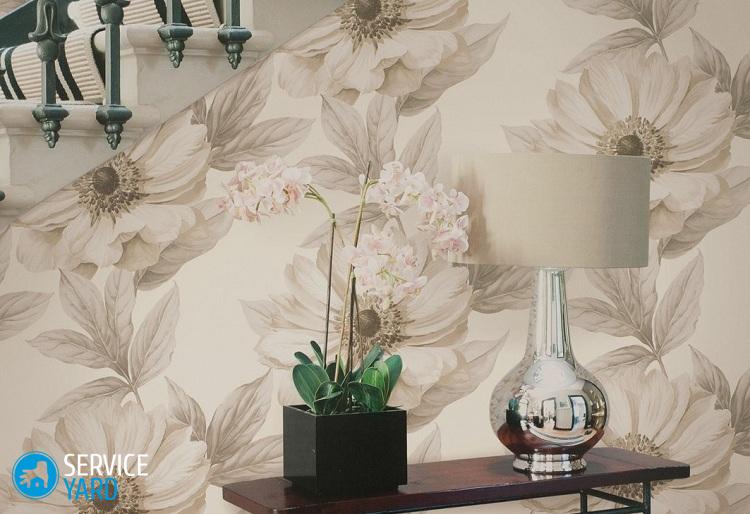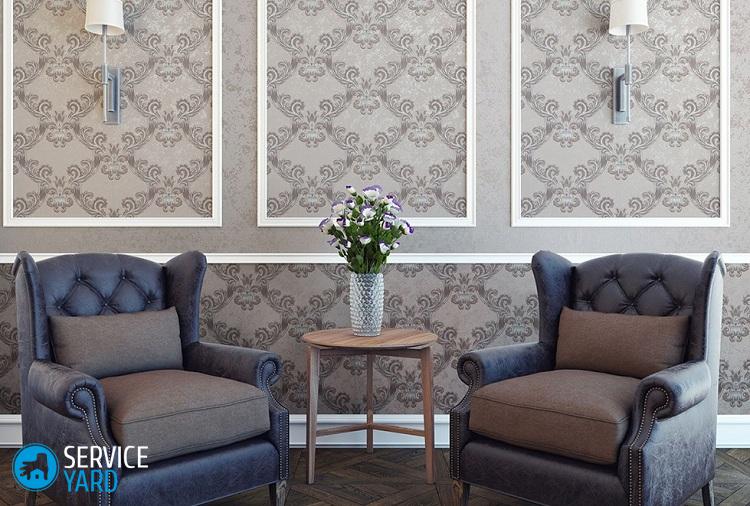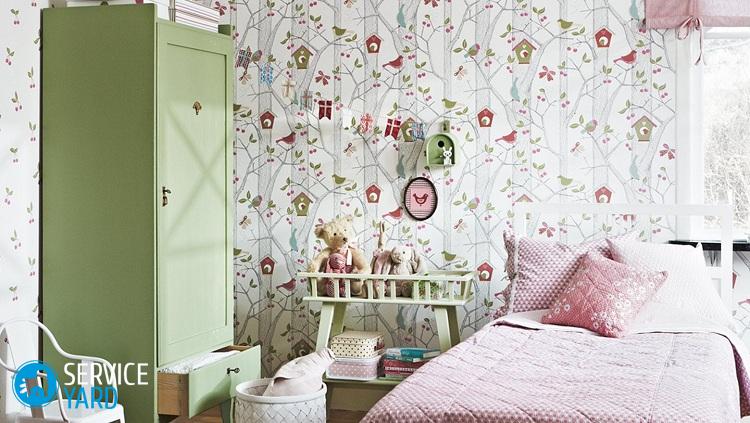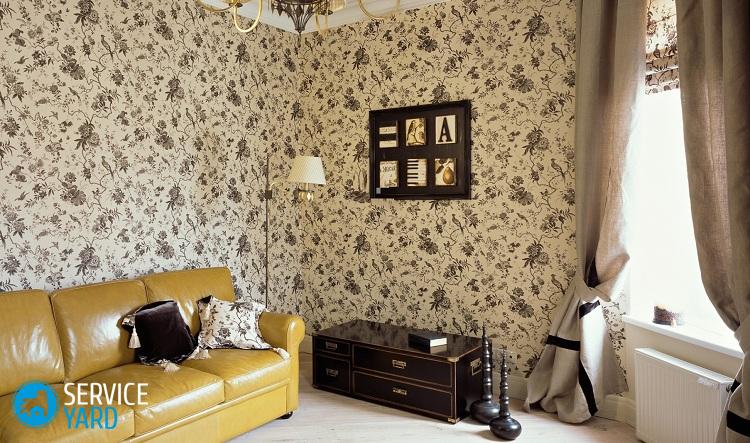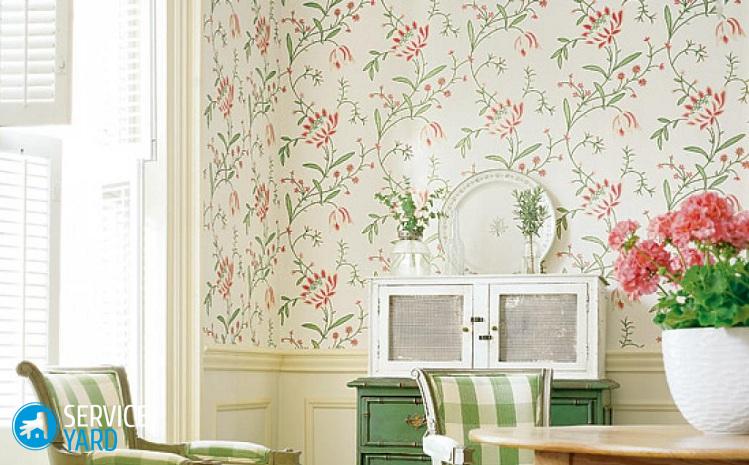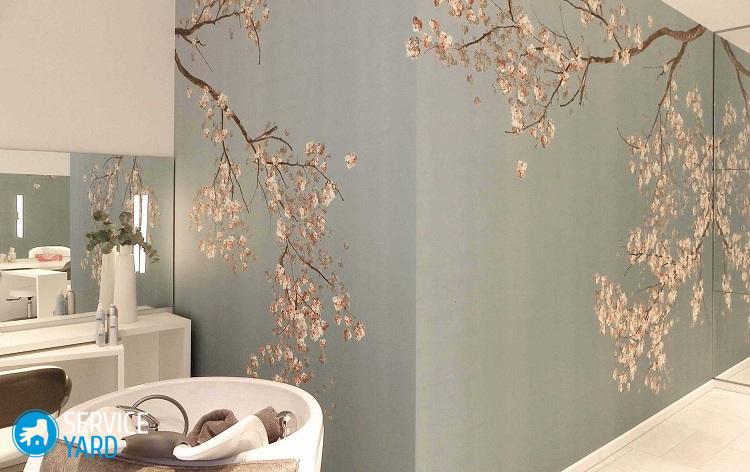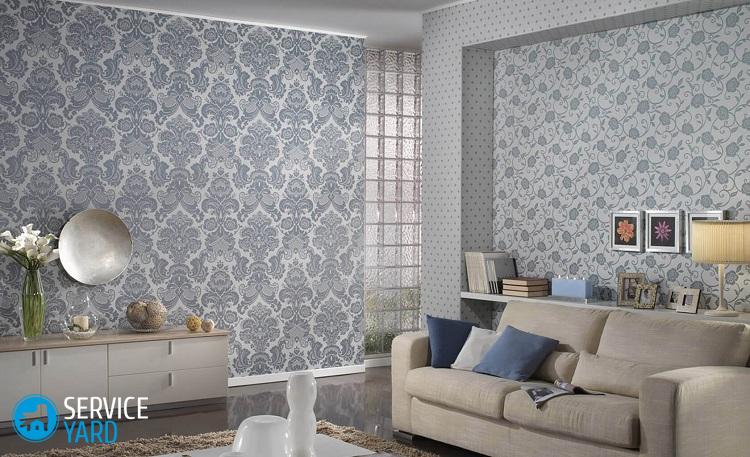Acrylic Wallpaper
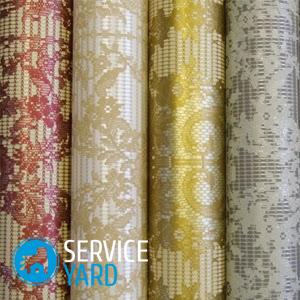
Acrylic wallpaper is an inexpensive and durable coating that can withstand wet cleaning. Due to these qualities, they compete in the modern market of finishing materials and are presented in a wide range. These coatings are a relatively new material, and many consumers confuse them with vinyl products. In this article, we will examine in detail all the features, pros and cons of this finishing option.
to contents ↑general information
In 1939, experts created a new invention - organic glass. This far time is characterized by the production of new acrylic material obtained chemically. Currently, acrylic has better quality characteristics than at the initial moment of production.
The construction market is represented by a huge assortment of acrylic materials that are designed for decoration, insulation and construction itself:
- Currently, acrylic wallpapers are made by spraying acrylic on a paper base, rather than the film that was previously used. With this pinpoint method, the material has free air penetration, which is very valuable and prides manufacturers of paper wallpapers.
- The surface of the wallpaper is voluminous, textured and looks very beautiful. Acrylic wallpapers fascinate with their beauty. When the weather is clear, sunny bunnies jump on the walls, the picture from this looks more voluminous, which makes the wall surface modern and original. If you prefer simple, inexpensive, but interesting wallpapers, then you should pay attention to these.
- They are convenient in sticking to the wall, while there are no problems with joining the picture.
- The appearance of acrylic paper paintings usually looks like - wallpapers are sold in rolls with a certain standard size - 0.53 m.
- On the front side of the material, small droplets or small strokes are visible, and it seems that the artist walked the wallpaper with a skillful hand. The variety of foam design is characterized by both familiar plant motifs and original abstractions. For fans of plain paintings, experts have developed a good assortment - such wallpapers will perfectly fit both in the bedroom, and in the living room, and in the children's room.
Types of acrylic wallpapers and their features
One of the disadvantages of this material is the small number of varieties, since there are only two of them. But this does not indicate a limited choice, but even vice versa - with several specific types there is a great variety of different shades, colors and structures, so this minus is not entirely significant.
Wall-paper acrylic on a paper basis
Paper-based acrylic wallpaper is the most environmentally friendly wallpaper, so experts recommend that they be used for the bedroom and children's room.
 But they have another small drawback, manifested in the gluing process. Like other paper canvases, it is not recommended to soak them for a long time. Otherwise, with prolonged exposure to moisture, which is contained in the adhesive, paper swells, which leads to damage to acrylic. Therefore, it is preferable to glue freshly spread strips directly onto the wall treated with glue without smoke breaks and not to harvest several fragments simultaneously.
But they have another small drawback, manifested in the gluing process. Like other paper canvases, it is not recommended to soak them for a long time. Otherwise, with prolonged exposure to moisture, which is contained in the adhesive, paper swells, which leads to damage to acrylic. Therefore, it is preferable to glue freshly spread strips directly onto the wall treated with glue without smoke breaks and not to harvest several fragments simultaneously.
Acrylic non-woven wallpaper
Non-woven acrylic wallpapers do not create a vapor-proof film, so this subspecies is neither the worst nor the best option compared to paper-based acrylics. But between them there is a fairly significant difference, which is expressed in many points.
Consider the main differences between paper webs and non-woven wallpaper:
- The non-woven base is characterized by an excellent reinforcing layer. Such canvases do not break even if there is a quite impressive crack on the drywall that can form as a result of improper installation. Non-woven is able to compensate for the expansion.
- Non-woven wallpaper is much easier to glue, since they do not need to be soaked when spreading with glue.
- Non-woven fabrics, the pattern of which does not have a certain step, does not need to be cut into strips. They are simply glued, while at the same time making a trim at the bottom of the wall.
Advantages and disadvantages
Acrylic wallpapers have their pros and cons.
Consider the advantageous qualities of acrylic wallpapers that come from the structure of the material:
- the material is able to withstand mechanical damage, so it is used for apartments in which animals and children live;
- the presence of high wear resistance;
- quite adequate cost;
- acrylic paintings “breathe”, so they are successfully used not only in hallways, as a kind of washing wallpaper, but also in bedrooms and living rooms;
- fungus and mold do not multiply in acrylic wallpaper;
- acrylic wallpapers are easy to wash, so their appearance remains impeccable for a long time, while using a slightly damp cloth for washing without using detergents;
- a large selection of colors and embossed surfaces allows you to use acrylic wallpaper in almost any room, while emphasizing the style of the interior, and the relief is able to hide many of the imperfections of the walls.
Along with the advantages, acrylic wallpapers also have disadvantages, which are very few and they are observed only when compared with other types of wallpaper:
- The small thickness of the outer layer causes abrasion of the coating. This minus is relative, because, depending on the conditions of care and operation, the service life of the wallpaper is about 10 years.
- The inability to use detergents during the washing process, but ordinary water can be used to remove contaminants.
Sticking Acrylic Wallpaper
The process of sticking acrylic wallpaper is no different from the technique of applying other wall coverings. The paper base is unpretentious to the choice of glue, the canvas adheres perfectly to any wall. Before you begin gluing, you need to prepare a wall, and the quality of the glued wallpaper depends on this procedure.
Preparing the wall for gluing
One of the important points is the preparation of the wall surface for gluing acrylic wallpaper. With an insufficiently responsible attitude, rather sad consequences of the repair can be observed.
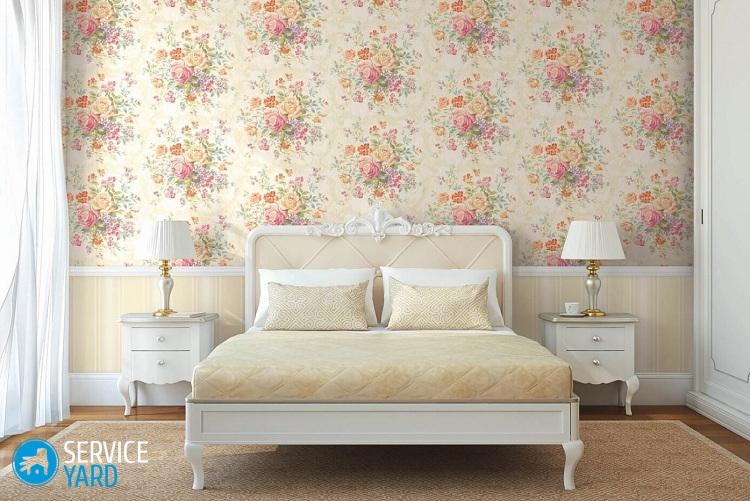
First of all, it is required to clean the wall surface from the remnants of previous finishing materials, such as paint, old wallpaper, poorly sticking putty and plaster. When removing old wallpaper, you may encounter some difficulties, because sometimes they are so firmly held that even a knife and spatula does not help to separate them. To facilitate the process, they need to be softened:
- Single-layer paper canvases are thoroughly wetted with a special solution that serves to remove wallpaper. In construction supermarkets, you can easily buy such funds. If necessary, such a solution is quickly prepared at home. To do this, a certain amount of wallpaper glue is added to the soap solution. The glue is used to ensure that the solution penetrates better to the paper base, while it lasts longer on paper, does not drain and does not dry out.
- When removing moisture-resistant options with acrylic or vinyl spraying, special technology should be used. Before applying the solution to the surface, scratches or cuts are preliminarily created using a clerical knife or a needle roller. Areas on which the paper base is especially firmly held are steamed through a wet rag with an iron.
- With a painted wall, the paint must also be thoroughly removed. Oil paint or enamel should be thoroughly cleaned with a metal scraper. In the case when the paint on the wall is very firmly held, use a grinding machine. You can use special chemical solvents, which you can choose at a hardware store.
- Aqueous emulsion paint can be easily separated from concrete or plaster with a metal spatula, and it should be periodically wetted in soapy water. Then you need to evaluate the basis of the wall. Putty or plaster should not have “bubbles”, do not exfoliate, but hold fast enough. To convince yourself of the strength of the base of the wall, tap with a solid object. The presence of a loud sound upon impact indicates that the plaster has peeled off in this area and needs to be removed.
Important! All plaster areas that have peeled off from a concrete or brick base should be carefully removed and then plastered again. If there are any cracks on the walls, they must be thoroughly putty so that subsequently they do not increase.
- If the walls are fully prepared, then for their gluing, a special composition is used, which primed the surface of the wall base. Currently, the modern market presents a huge assortment of various primers, such as mineral, alkyd, acrylic. The use of a primer makes it possible to greatly simplify the process of gluing acrylic wallpaper, in addition, it strengthens the base of the wall, prevents its shedding, improves adhesion, the so-called “adhesion” of the wall to wallpaper glue.
After you have completed all the preparatory work, you can proceed to the direct gluing of wallpaper.
Wallpaper glue selection
The modern market presents a huge number of diverse adhesive compositions. It is necessary to choose glue slowly and carefully, since the quality of the glue affects the adhesion strength of the base to the paper web. Paper is an unpretentious material for the technical characteristics of the adhesive composition. The paper base is characterized by the property of excellent interaction with any glue, while absorbing it well:
- A popular glue option is bustilate or PVA building. Such glue is characterized by excellent adhesion, due to which there is a strong adhesion of paper to the wall. But at the same time, an airtight layer is created on the wall surface. Since there is a very strong hitch, it is not so easy to carry out subsequent repairs, in which the top layer of plaster is separated together with a layer of bustilate and a paper base.
- The best option for gluing acrylic paper wallpapers are specially designed factory compounds. Such formulations are made from modified starch by the addition of various ingredients that can prevent the development of mold and fungi on a paper web.
Important! In order to meet the glue and the specified technical characteristics, at the time of preparation, you should strictly adhere to the instructions that are on the package.
Wall marking
Before starting work, it is necessary to make a vertical marking on the wall, thanks to which paper can be glued as evenly as possible. The marking should begin in the same way as the gluing process - from one of the corners of the room.
How to make a wall layout:
- Using a plumb line or level, draw a vertical line from the ceiling to the floor surface.
- From this trait we begin to glue the wallpaper.
- After that, measure the height of the ceilings, cut into strips of the appropriate length, while adding 5-10 cm to allowances.
- We spread the canvas on the floor and, applying glue, lubricate it.
Glue application
When sticking acrylic paper paintings, a certain technological process is required:
- First we put glue on the wall, and then on the paper base of the strips.
Important! The glue should be applied in a thin layer, since excessive moisture is poorly tolerated by the paper sheet, oversaturation leads to deformation of the paper, as a result - after sticking and drying, warping of the sheet and displacement of the pattern may occur.
- We fold the paper web in half and leave it for 5-10 minutes, while the oiled side should be inside;
- After uniform impregnation with glue, we glue the paper sheet to the wall.
Wallpapering on the wall
Sticking acrylic wallpapers is a rather time-consuming process, so this procedure is much easier to do together, while the work will be done much faster and better:
- The canvas, which is smeared with glue, is applied to the wall surface so that the edge is aligned with the vertical marking line. Bottom and top of the canvas should be overlaps, which after finishing work when leveling the wallpaper are removed with a clerical knife.
Important! In the process of gluing wallpaper made on a paper basis, it should be ensured that there are no drafts that adversely affect the drying process of the paintings. In addition, the option of uneven drying of the glue is possible, as a result - peeling of the base from the wall can occur. Therefore, it is recommended to close all windows and doors.
- We also lubricate the second canvas with glue, fold it in half and wait a few minutes. Glue the second strip butt with the previous canvas.
- Similarly, we stick the remaining strips of wallpaper.
- When you reach the opposite corner, we cut the strip of wallpaper from top to bottom so that the edge 4-5 cm comes on an adjacent wall surface.
- To smooth out irregularities that occurred during gluing, we use a special plastic spatula.
- Excess glue that we squeeze out from under the cloth can be removed with a dry cloth. Air bubbles that have formed under the base can be pierced with a needle, and then smoothed.
Wallpaper Care
When caring for acrylic wallpaper, try not to overdo it:
- Wall coating with acrylic spraying is quite “delicate”, the use of rough brushes and sponges can lead to deterioration of the material. Therefore, it is best to use ordinary water when cleaning.
- If a stain appears that cannot be erased when using water, then you need to carefully choose a detergent. Some supermarkets provide special formulations that are designed to remove contamination from washing wallpapers. After choosing a suitable detergent, apply it in a small amount to a rag and rub it gently over the contaminated area. After - with a damp cloth or sponge soaked in water, wipe the surface of the wallpaper.
to contents ↑Important! For cleaning acrylic wallpaper on a paper basis, it is not recommended to use abrasive products, the use of which can permanently spoil the wall covering.
Is there any harm from acrylic wallpaper?
Many consumers are constantly wondering how harmful and safe it is to use beautiful wallpapers made on the basis of artificial materials. This type of wall covering fully meets all the requirements of GOST, and this type can be used without problems in any room of a house or apartment. The presence of a large number of certificates confirms the safety of wallpapers that are “breathable”.
As a result of the studied properties of acrylic paintings, we can conclude about the convenience, wear resistance, strength and excellent appearance of this material. With such wallpaper you can decorate not only the walls, but also paste them over the ceiling. Since acrylic is sprayed onto a paper base, it also adheres very well to the substrate.
to contents ↑Stock footage
Like any other material, this product with a similar spraying is not ideal, it has some minor disadvantages. But acrylic canvases can be safely purchased on the market, in a construction supermarket or ordered from a catalog in a network of online stores, and begin the long-awaited repair.
- How to choose a vacuum cleaner taking into account the characteristics of the house and coatings?
- What to look for when choosing a water delivery
- How to quickly create comfort at home - tips for housewives
- How to choose the perfect TV - useful tips
- What to look for when choosing blinds
- What should be running shoes?
- What useful things can you buy in a hardware store
- Iphone 11 pro max review
- Than iPhone is better than Android smartphones



